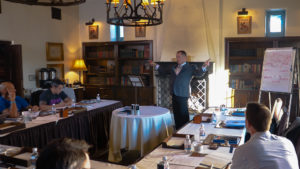While Twitter, Facebook, and Instagram provide opportunities to connect with friends and family, LinkedIn is the only social media platform solely focused on our professional lives. When used strategically and thoughtfully, a LinkedIn company page is a powerful tool to boost your business, expand your network, and gain the attention of new and existing customers.
A successful LinkedIn marketing strategy can help expand brand awareness and lead to new leads and partnerships, but it requires patience and consistency. As with any tool, wielding LinkedIn well can deliver positive results, while haphazard use can have undesirable effects.
As Intero Advisory’s first licensed partner implementing their ‘It’s Business, Not Social™’ methodology, I help today’s leaders and entrepreneurs develop a LinkedIn growth strategy to enhance their business presence, reach, and impact. Below, you’ll find my top 8 tips for leaders like you to navigate and succeed at using LinkedIn for your business.
1. Keep Your Profile up to Date
Before setting up your LinkedIn business page, make sure your profile is up to date and includes any new achievements, skills, certifications, and other advancements you’ve made. While you may be anxious to get your LinkedIn business account underway, you need to have an up-to-date profile that reflects the person behind the brand, as well.
When updating your profile, aim for 100% completeness. Your profile should reflect your personality, but be mindful of your voice and tone. Like your website copy, your LinkedIn company page and profile represent the voice and public face of your business. It may take time to perfect your voice and hone your message, but your efforts will be worth it.
2. Create a Business Page
As evidenced by the more than 30 million LinkedIn business pages, LinkedIn is a powerful mechanism for companies to boost their brand’s visibility to other businesses and prospective customers, employees, and partners.
Like your LinkedIn profile, your business page communicates who you are, what you do, and why you do it. Your page copy should reflect your brand’s authentic voice and be consistent with the personality on display on your website and in other marketing materials.
At its most basic, your LinkedIn company page is a window into your business. Page visitors will develop an impression of you and your company based on what they see, so it’s essential to employ a LinkedIn strategy both while creating and growing your page.
LinkedIn provides plenty of resources to help you set up a new LinkedIn company page. If you already have a personal LinkedIn page and verified email address, you can set it up now by following the instructions laid out here.
3. Define Your Goals
As you set up or update your personal and business pages, consider your goals. What do you hope to accomplish by using LinkedIn for your business? These goals will help form the foundation of your LinkedIn growth strategy and serve as your north star when creating content and engaging on LinkedIn.
Clear and measurable goals will also ensure others see you the way you intend. To ensure you’re gaining value from the time you invest in LinkedIn, each piece of content you create, share, or comment on should align with one of these goals.
4. Define Your Target Audience
LinkedIn provides businesses with powerful tools to zoom in on their target audience. However, before you can take advantage of these tools, you’ll need to define your target audience first.
With your goals already defined, narrowing down your key audience becomes much more manageable. If one of your goals is lead generation, for example, you can narrow your audience to decision-makers in your target industry based on job function, title, or even company. On the other hand, if you’re aiming to increase local brand awareness, you can employ LinkedIn’s geographic filters to reach local businesses, professionals, and members of local media.
5. Develop a Content Plan
A content plan is your guide to creating consistent and engaging content. Your plan will reflect your goals and the content types and frequency that resonate best with your target audience. Your content plan can also help you gain the most mileage from each piece of content you create. For example, you can plan to break out one infographic into several informative articles or identify older posts in your content repository to update and re-share.
When you create your LinkedIn content plan, be realistic. Don’t plan to post original content every day when you know you won’t have the time to achieve it. If you’re unsure where to start, you can explore some of the content planning resources in the LinkedIn Business Solutions library to get a basic idea of what your plan should include.
A content plan is your guide to creating consistent and engaging content. Your plan will reflect your goals and the content types and frequency that resonate best with your target audience. Your content plan can also help you gain the most mileage from each piece of content you create. For example, you can plan to break out one infographic into several informative articles or identify older posts in your content repository to update and re-share.
When you create your LinkedIn content plan, be realistic. Don’t plan to post original content every day when you know you won’t have the time to achieve it. If you’re unsure where to start, you can explore some of the content planning resources in the LinkedIn Business Solutions library to get a basic idea of what your plan should include.
6. Continuously Post Engaging Content on Your Company Page
The key to an impactful content strategy on LinkedIn is engagement. You can’t expect others to engage with your content if it’s not thought-provoking or valuable. Ask yourself what types of conversations you hope to spark and whether your content will encourage them.
Your network can potentially see hundreds of unique pieces of content each week. What will make your content spur engagement? If you’re announcing a milestone or a new product launch, how can you tailor your delivery to meet your audience’s needs and interests? If you’re sharing your insight or expertise, what problem are you solving that your audience won’t find elsewhere?
Content on LinkedIn differs from other social media platforms. Hard-selling and similar tactics are frowned upon on LinkedIn. This is why it’s crucial to develop and follow a LinkedIn strategy and why it’s rare for businesses who “wing it” on LinkedIn to see the results they desire.
7. Engage, Engage, Engage!
Authentic engagement with content shared by your network demonstrates your genuine interest in others and allows you to show your expertise. Though you can “like” content on LinkedIn, your goal should be quality engagement. Sharing or adding meaningful comments about the value you gained from others’ content shows you’re doing more than clicking and scrolling.
When others comment on your posts, do your best to respond. Not only does this show you value their input and feedback, but it can spur dialogue and help further develop your relationships.
8. Monitor Your Analytics
As with any SMART goal, you need a way to measure your progress if you hope to succeed. LinkedIn’s analytics can offer significant insight into the impact your efforts are having.
Your LinkedIn strategy will determine what you measure. For example:
- If your goal is to further your brand as a thought leader, you might choose to measure your content’s success by the number of shares it receives.
- If you’re focused on building new relationships, you may be more interested in measuring connect requests and comments.
If you’re not progressing toward your goal, monitoring your analytics can also reveal a need to change course. It might take some time to identify where the disconnect between your efforts and your desired results lies, but closely monitoring the data will allow you to make changes and monitor their impact until you strike the right balance.
Conclusion
At Leader’s Cut, I partner with leaders and entrepreneurs like you to craft a LinkedIn strategy and implementation plan that nurtures and expands their desired networks and helps achieve their sales, marketing, and recruiting goals.
If you’d like to learn more about working with me as a business coach or the ‘It’s Not Business, It’s Social”’ methodology from Intero Advisory, let’s talk. You can view my calendar, watch a video demonstration of a typical “Meet and Greet” conversation with me, and, when you’re ready, schedule a free 15-minute consultation with me here.
Ken Kilday is an Entrepreneur, Executive Business Coach, Business Strategist, and LinkedIn Expert.




